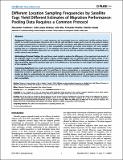Por favor, use este identificador para citar o enlazar a este item:
http://hdl.handle.net/10261/64106COMPARTIR / EXPORTAR:
 SHARE SHARE
 CORE
BASE CORE
BASE
|
|
| Visualizar otros formatos: MARC | Dublin Core | RDF | ORE | MODS | METS | DIDL | DATACITE | |

| Título: | Different Location Sampling Frequencies by Satellite Tags Yield Different Estimates of Migration Performance: Pooling Data Requires a Common Protocol |
Autor: | Tanferna, Alessandro CSIC ORCID ; López-Jiménez, Lidia CSIC ORCID; Blas, Julio CSIC ORCID ; Hiraldo, Fernando CSIC ORCID; Sergio, Fabrizio CSIC ORCID | Fecha de publicación: | 2012 | Editor: | Public Library of Science | Citación: | PLoS ONE 7 (2012) | Resumen: | Background: Migration research is in rapid expansion and increasingly based on sophisticated satellite-tracking devices subject to constant technological refinement, but is still ripe with descriptive studies and in need of meta-analyses looking for emergent generalisations. In particular, coexistence of studies and devices with different frequency of location sampling and spatial accuracy generates doubts of data compatibility, potentially preventing meta-analyses. We used satellite-tracking data on a migratory raptor to: (1) test whether data based on different location sampling frequencies and on different position subsampling approaches are compatible, and (2) seek potential solutions that enhance compatibility and enable eventual meta-analyses. Methodology/Principal Findings: We used linear mixed models to analyse the differences in the speed and route length of the migration tracks of 36 Black kites (Milvus migrans) satellite-tagged with two different types of devices (Argos vs GPS tags), entailing different regimes of position sampling frequency. We show that different location sampling frequencies and data subsampling approaches generate large (up to 33%) differences in the estimates of route length and migration speed of this migratory bird. Conclusions/Significance: Our results show that the abundance of locations available for analysis affects the tortuosity and realism of the estimated migration path. To avoid flaws in future meta-analyses or unnecessary loss of data, we urge researchers to reach an agreement on a common protocol of data presentation, and to recognize that all transmitter-based studies are likely to underestimate the actual distance traveled by the marked animal. As ecological research becomes increasingly technological, new technologies should be matched with improvements in analytical capacity that guarantee data compatibility. © 2012 Tanferna et al. | URI: | http://hdl.handle.net/10261/64106 | DOI: | 10.1371/journal.pone.0049659 | Identificadores: | doi: 10.1371/journal.pone.0049659 issn: 1932-6203 |
| Aparece en las colecciones: | (EBD) Artículos |
Ficheros en este ítem:
| Fichero | Descripción | Tamaño | Formato | |
|---|---|---|---|---|
| journal.pone.0049659.pdf | 390,48 kB | Adobe PDF |  Visualizar/Abrir |
CORE Recommender
PubMed Central
Citations
2
checked on 17-abr-2024
SCOPUSTM
Citations
15
checked on 11-abr-2024
WEB OF SCIENCETM
Citations
13
checked on 27-feb-2024
Page view(s)
374
checked on 18-abr-2024
Download(s)
252
checked on 18-abr-2024
Google ScholarTM
Check
Altmetric
Altmetric
Artículos relacionados:
NOTA: Los ítems de Digital.CSIC están protegidos por copyright, con todos los derechos reservados, a menos que se indique lo contrario.
